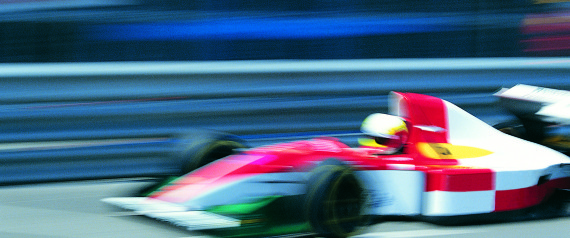History always conjures up striking images for us - gory battlefield deaths, royal courts shadowed with intrigue, revolutionary violence and heroism, turbulent cityscapes, domestic dramas, appealing human icons, monstrous villains.
But history has an extraordinary soundtrack, too. Indeed, the past - even the pre-industrial past - was rarely quiet. It was full of chanting, bell ringing, roaring crowds, raucous debauchery, gunfire, music, and, of course, the human voice - mumbling, crying, singing with pleasure, shouting in anger, screaming in pain. Sometimes, these noises were more than a backdrop to the action. They were charged with meaning, a matter of life or death. They were a vital part of the story. They actually shaped events.
It's been said that sound is a way of "touching at a distance." It reaches out from the distant past, too - like a sudden mental switch across time, connecting us at a visceral level with a long gone age. When we turn up the volume of history, we're no longer detached witnesses: we find ourselves fully immersed in the extraordinary sensory worlds of our ancestors. Instead of looking back at them through a telescope, as they fumble and fight their way through some of the great dramatic episodes of the human story, we are - for a moment at least - right there with them.
Here, then, are ten sounds that changed the course of history in subtle but significant ways. They take us from the Palaeolithic to the present. And they remind us of the sheer power of sound: the way it's always wrapped itself around us - offering vital clues about the world, changing our moods, inspiring us, frightening us, disciplining us, bonding us, dividing us.
1. Echoes in the Cave
Stand in a certain part of a Utah canyon, or one of the deepest chambers of a cave in Europe. Then hum, shout, or sing. The rocks will call back to you. These are resonant places. They're also full of prehistoric art. In fact, several archaeologists reckon the biggest concentrations of paintings or carvings are precisely where the echoes are strongest. So could it be that, tens of thousands of years ago, the people who wandered these dark passages were drawn in the first instance by their acoustic properties? When they created a cacophony, it must have seemed to them as if they were conjuring up the sounds of something invisible, something within the rock speaking back - as if they were communicating with another, spirit world. In these moments of music and chanting, we're witnessing not just the birth of art but also, perhaps, the origins of religious experience itself.
2. The Singing Hunters
In the 1980s a young American, Louis Sarno, recorded the BayAka pygmies of central Africa. They were performing a ceremony to mark the beginning of a hunt. The hunters among them chanted and drummed away. But their musical skills evidently weren't up to scratch, because others, in the guise of forest spirits, soon started to harangue them noisily. For the BayAka - as it must have been for our distant hunter-gatherer forebears - it was all a matter of co-ordination. If hunters can't chant and drum in time, what chance of working effectively as a group when chasing down animals? Over thousands of years, it's been rhythm that has primed us for co-ordinated action. In the process, it's also been an extraordinarily powerful means of binding us together in kinship. Sing together, drum together - and tomorrow we shall eat together!
3. The Roaring Crowd
In 55BC, at the Circus Maximus in the centre of ancient Rome, the politician Pompey put on a spectacular show. To curry favour with the crowd, he offered a special treat to accompany the usual diet of processions, combats and burlesques: the slaughter of elephants. The crowd delighted in it - at least, at first. But when they heard the poor creatures' death throes, Pompey's plan backfired horribly: the spectators 'rose in a body' and heaped 'dire curses' on their host. This wasn't quite free expression: the people gathered at Roman Games were always fickle pleasure-seekers - and always open to manipulation by claques. But the cauldron of noise they could create in a matter of seconds when gathered together was a warning to the governing class. A crowd could turn. It could speak the unspeakable. And its visceral, instinctive roar was a crude foretaste of the popular democracy to come.

4. The Bell
Bells have been rung for thousands of years - and right across the world. In almost every case they were used because of an ancient belief in their sacred power to dispel evil. The sound they sent flying through the air when rung was regarded as magic fighting magic, creating a powerful protective aura. In Medieval Christendom, the bell was the backdrop to life, from cradle to grave: proclaiming a birth, sounding the death knell, marking time every day inbetween. In 17th Century New England, it summoned nervous colonists to town assemblies for mutual aid. And every time it rang out from a temple or church or tower - announcing when to rise, when to pray, when to retire indoors for the night, when to take up arms - it tightened both secular and religious authorities' hold over the daily life of all within hearing distance.
5. Singing the Revolution
1789. The soundtrack of the French Revolution wasn't only that of the frenzied mob. It was also that of a satirical song. If you went strolling among the cafes and boulevard sideshows of the Palais-Royal in Paris, you'd soon hear a rich Rabelaisian brew of gossip and muttering, poetry and music, all heaping scorn on the monarchy. Drifting through the crowds, too: the words of Ah! Ça ira, with its rousing message of hope and change. The song belonged to no one - and, so, everyone. As more people sang along, its lyrics mutated, darkened. Soon the Sans-Cullotes were trilling about hanging aristocrats: "If we don't hang them, we'll break them," they roared; "if we don't break them, we'll burn them". You can trace the rising desperation of the French people during the Revolution - perhaps of all people during all revolutions - by listening closely to the protest songs of the street and how they evolve. A nation's political mood is always, as they say, 'in the air'.
6. The Gurgling Chest
Doctors have been putting their heads to a patient's chest to hear the human heart beating away inside for centuries. But when physicians in Paris and Edinburgh invented the stethoscope at the end of the eighteenth century, a vastly expanded spectrum of fleshy hisses and rattles was revealed for the first time, our inner cavities laid bare in all their complexity. Doctors needed to quickly retune their ears so they could start deciphering this new soundscape: a nice resonance that announced clear passages, a thick dullness that warned of dangerous congestion, or a subtle alphabet of buzzing, crackling, and gurgling inbetween. The human body was starting to speak for itself. A sign that medical science was unveiling new and startling dimensions to the natural world.
7. Rebel Yells
One of the distinctive sounds of the Civil War of 1861-65 was the 'rebel yell' of the Confederates. With its high-pitched ululating, whooping and howling, it was fabled for terrorising the enemy. But Union troops shouted too. As, of course, have soldiers from time immemorial. Wars can involve stretches of silence and fighting by stealth. But mostly they're noisy as hell. And noise itself has frequently become the weapon: the beating of drums, the sounding of bugles, the clanking of armour, the roar of charging men. As for gunfire, it might kill one soldier with its bullet, but it will instil fear for many more within earshot. When, during the First World War, tens of thousands of troops suffered from 'shell shock', most had simply been worn to a shred by the constant din of artillery. For years afterwards, too, their nightmares would be this: hearing imaginary shells exploding in their heads. A generation tormented still by the sounds of battle.
8. Voices from the Dead
By the 1870s the ancient dream of being able to capture, store and replay sound was finally a reality. But what to do with this new power? What excited people most people at the time was not the phonograph's or gramophone's ability to play back music but the opportunity it presented to record a human voice for posterity - or, as Thomas Edison put it, to capture "the last words of a dying man". Families would draw the parlour curtains, invite friends around, and summon up the bodiless voices inside the machine, creating a new kind of séance. When they later became portable, and discs more robust, people would take gramophones with them wherever they went. They found in recorded music a new and powerfully emotional way to connect - not just with the past, but also with home and family, and, of course, their own memories.

9. The Motor Car
The motor car was welcome at first. After the noisy clatter of horse-drawn carriages with their iron-rimmed wheels hurtling across cobbled streets, the prospect of rubberized tyres on smooth tarmac was alluring to most town folk in the closing decade of the 19th Century. By the time the Scottish doctor Dan McKenzie published The City of Din in 1916, there was a new note of despair: vehicles had got heavier, faster, and - through the sheer explosion in their number - louder. When New Yorkers were asked in 1929 to list their top ten most irritating noises, they all turned out to be machine-made: car horns, radios blaring, and, above all, the relentless roar of street traffic. The modern metropolis was still a place of wonder and excitement. But it felt as if our age-old opportunity to enjoy public spaces was now under threat as never before. The noise of the internal combustion engine was the perfect emblem of a new tipping-point - when the advantages of modernity seemed to go into reverse.
10. Muzak
Who to blame? Erik Satie for his idea of bland and repetitive 'furniture music', conjured up over a noisy lunch with Fernand Léger? Or the American ex-army radio engineer, George Owen Squier, with his scheme for wiring canned music into restaurants, shops and hotels? Either way, by the 1930s cities like New York were awash with background music - much of it pumped out by the Muzak Corporation. Its deliberately unobtrusive melodies certainly helped to calm nerves in new-fangled zooming elevators. It was undoubtedly an agreeable alternative to boredom for those doing repetitive work. But it also felt ubiquitous - and always on. Worse, like a vision from Huxley's Brave New World, it was organised to a rhythm that tried getting us to work harder, eat faster, buy more. Background music feels emblematic of our whole condition: losing control of our own environments - and needing, urgently, to turn back down the volume dial in our own lives.
David Hendy is the author of "Noise: A Human History Of Sound And Listening" [Ecco, $27.99].